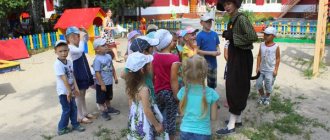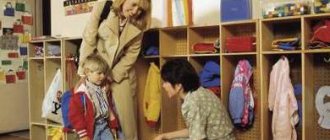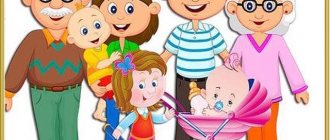Summary of the parent meeting Topic: “Senior preschool age, what is it like?”
MUNICIPAL BUDGETARY PRESCHOOL EDUCATIONAL INSTITUTION
"KINDERGARTEN No. 37 "ROSINKA" VORKUTA
Parent meeting in the senior group "Rosinka"
Topic: “Senior preschool age, what is it like?”
Participants: Teachers, parents.
Yashchenko Elena Mikhailovna
Educator
October 2022
Parent meeting in the senior group "Rosinka"
Topic: “Senior preschool age, what is it like?”
Purpose: To familiarize parents of pupils with the age characteristics of children in the senior group.
Objectives: Consider the age characteristics of children 5–6 years old, introduce parents to the educational process in the older group. Promote the emotional rapprochement of all participants in the educational process and organize their communication.
Meeting plan:
1. Introductory part.
2. Speech by the head “Comprehensive safety of preschool educational institutions. Registration of compensation for part of the parental payment for childcare and supervision.”
3. Age characteristics of children 5-6 years old.
4. Familiarization of parents with the educational process in the senior group.
5. Game “Color the flower”
6. Briefly about miscellaneous things.
7. Selection of the parent committee.
8. Final part.
Progress:
Introductory part.
Educator: Good evening, dear parents! We are very pleased to see you at the meeting today. We will begin our meeting with the selection of a secretary.
New children have joined our group - let's get to know each other. (Welcome and introduction to parents of new children). This is how we met.
The manager came to meet us. We give her the floor.
Speech by the head on the topic: “Comprehensive safety of preschool educational institutions. Registration of compensation for part of the parental payment for childcare and supervision.”
Speech on the topic: “Age characteristics of children 5-6 years old.”
Each child develops in his own way, each has his own path and pace of development.
We present to your attention a general age portrait of a 5-6 year old child, with indicators of different aspects of his development.
Age 5 - 6 years is the senior preschool age. It is a very important age in the development of the child’s cognitive sphere, intellectual and personal.
At 5-6 years old, a child absorbs all cognitive information like a sponge. It has been scientifically proven that a child at this age remembers as much material as he will never remember later in his life. At this age, the child is interested in everything related to the world around him and expanding his horizons. The best way to get scientific information is to read a children's encyclopedia, which clearly, scientifically, in accessible language describes to the child any information about the world around him. The child will gain an understanding of space, the ancient world, the human body, animals and plants, countries, inventions and much more.
This period is called sensitive, i.e. most favorable for the development of all cognitive processes: attention, perception, thinking, memory, imagination. To develop all these aspects, the game material becomes more complex, it becomes logical, intellectual, when the child has to think and reason.
It is good at this age to play word games with the child, since the child already uses synonyms and antonyms in his speech, distinguishes between vowels and consonants, and can determine the number of syllables in words, the place of the sound in the word (beginning, middle, end of the word).
The designer develops logical thinking well. The important point here is folding according to a pattern - a pattern, starting with simple patterns. Cubes, various puzzles, mosaics must be laid out according to the picture, focusing on color, shape, size.
Various logical tables develop all analyzers - visual, logical, verbal. For example, the game “Odd Four” - the pictures show various objects. Of the four items, one is extra. The child must think and choose this extra item and say why it is extra. Game "Place in order." A series of illustrations are offered, related to the same theme, but laid out incorrectly. The child must determine which of the illustrations depicts what happened earlier or later - that is, put it in order. Here the child must see the sequence, trace the logical pattern and justify it.
At the age of five, cognitive and intellectual spheres actively develop. And the better developed attention, perception, thinking, memory, imagination, the better and faster the child develops, the better prepared he is for school.
Speech on the topic: Introducing parents to the educational process in the senior group.
We would like to remind you that we are now the senior group. Our daily routine, hours and number of classes per day have changed. Now each lesson lasts 25 minutes and there are 12 lessons per week.
Your children have gotten older, and as a result, their responsibilities have increased. Both the program and teaching methods acquire the character of educational activity.
In order for the educational process to be properly organized, in our work we rely on the main regulatory documents regulating the activities of preschool educational institutions:
- The federal law ;
- Federal State Educational Standard for Preschool Education;
- SanPin 2.4. 1. 2660-10.
- International Convention on the Rights of the Child.
We work according to the preschool education program “From birth to school” edited by Veraksa N.E., Vasilyeva T.S., Komarova M.A.
We prepare children for school, develop perseverance, curiosity, attention, and memory. And it is the joint work of us teachers and you, parents, that can give a positive result.
We would like to introduce you to what children should know by the end of the school year.
Cognitive development:
Formation of elementary mathematical concepts.
By the end of the school year, children should be able to count objects within 10. Be able to indicate the number of objects with the corresponding number.
Be able to divide a square into 4 equal parts and name the parts.
Be able to navigate on a sheet of paper, determine the sides, corners and middle of the sheet.
Be able to distinguish and name flat and three-dimensional geometric shapes (circle, square, triangle, rectangle, ball, cube, cylinder).
Be able to consistently name the days of the week, determine what day of the week is today, what it was yesterday, what it will be tomorrow.
Familiarization with the social and objective world:
Have some ideas about educational institutions (school, kindergarten, college, university, etc.).
Have ideas about professions.
Have an idea of how seasonal changes affect people's lives and work.
Have primary ideas about the diversity of peoples of the world, races, nationalities.
Classify and compare objects by purpose, color, material, shape.
Distinguish and name types of transport.
Getting to know the natural world around you:
Have an understanding of living and inanimate nature, seasonal changes in it and human activities. About plants, mushrooms, animals, as representatives of living things in the natural world, their basic life functions and needs, and habitat. About natural communities of animals and plants, their relationships and features of adaptation to the environment and seasonal changes in it.
Speech development:
Use all parts of speech, actively engage in word creation, use synonyms and antonyms.
Choose several adjectives for the noun; replace a word with another word with a similar meaning.
Determine the place of a sound in a word, divide the word into syllables, count the letters in a word, come up with a word starting with a given letter.
Share various impressions with the teacher and other children, refer to the source of the information received (TV show, story of a loved one, visiting an exhibition, children's play, etc.).
Make up your own short story on a given topic.
Have a fairly large vocabulary.
Participate in the conversation and express your opinion.
Compose stories based on a plot picture, based on a set of pictures; consistently, without significant omissions, retell short literary works.
Retell short tales and stories coherently, consistently and expressively.
Artistic and aesthetic development:
In drawing:
Create images of objects (from life, from an idea), plot images.
Use a variety of compositional solutions and visual materials. Know the features of visual materials.
Use different colors and shades to create expressive images.
Make patterns based on folk arts and crafts.
In sculpting:
Sculpt objects of different shapes using learned techniques and methods of sculpting.
Create small plot compositions, conveying proportions, poses and movements of figures.
Create images based on folk toys.
In the application:
Depict objects and create simple plot compositions using a variety of cutting techniques and tearing paper.
In design:
Design according to your own ideas.
Analyze a sample building.
Plan the stages of creating your own building, find constructive solutions.
Create buildings according to a drawing or diagram.
In music:
Distinguish between genres of musical works (march, dance, song); sound of musical instruments (piano, violin).
Distinguish between high and low sounds.
Sing without tension, smoothly, with a light sound; pronounce words clearly, start and finish the song in a timely manner; sing accompanied by a musical instrument.
Move rhythmically in accordance with the character and dynamics of the music.
Perform dance moves.
Social and communicative development:
Development of gaming activities:
Agree with partners on what to play, who will be who in the game; obey the rules of the game, develop the content of the game depending on the number of children playing, explain the rules of the game to peers. Accompany game interaction with speech. Resolve controversial issues and resolve conflicts in the game with the help of speech: convince, prove, explain. In games, evaluate opportunities and accept loss without resentment.
Self-care skills:
Possess basic self-care skills: dress and undress independently, dry wet things, keep your closet in order; use cutlery (spoon, fork, knife) correctly.
Introduction to work:
Responsibly perform the duties of a dining room attendant and set the table correctly. Participate in maintaining order in the group and on the territory of the kindergarten. Carry out feasible work assignments, understanding the significance of your work, and demonstrate the ability to bring the work started to completion.
Formation of security fundamentals:
Follow the basic rules of safe behavior in kindergarten. Observe basic rules of behavior on the street and in transport, basic traffic rules. Distinguish and name special types of transport (“Ambulance”, “Fire”, “Police”), explain their purpose. Understand the meaning of traffic lights; recognize and name the road signs “Pedestrian crossing”, “Children”, “Tram stop”, “Bus stop”, “Underground pedestrian crossing”, “First aid station”. Distinguish between a roadway, a sidewalk, an underground pedestrian crossing, and a zebra crossing. Observe basic rules of behavior in nature (ways to safely interact with plants and animals, respect for the environment).
Physical development:
Walk and run easily, rhythmically, maintaining correct posture, direction and pace.
Climb the gymnastics wall with changes in tempo.
Jump on a soft surface, long jump from a place, jump over a short and long rope.
Throw objects with the right and left hands at a distance of 5-9 meters, combine a swing with a throw, throw the ball up onto the ground and catch it with one hand, hit the ball on the spot. Form into a column of three or four; align, open in a column, line; make turns right, left, around.
Use physical education equipment outside of class (in your free time).
Educator: We hope that with common efforts we will achieve all this.
Educator: Now let’s rest a little and play a game.
Game "Color the flower"
Educator: Take everything one flower at a time. Color them (there are flowers of the same size, shape, and colored pencils on the tables). Now compare your flower with the flowers of your neighbors. All the flowers were the same in size, color, and shape.
Educator: Tell me, after you have painted a flower, can you find two completely identical flowers? (No). Under the same conditions, we do everything differently.
Hence the rule: Never compare your child with other children! All children are different and adults too. Rejoice in his personal achievements and successes.
Briefly about different things.
Educator: Continuing our meeting, we will talk briefly about different things.
We would like to remind you of the safety rules. About safety measures both in kindergarten and outside. In connection with the current situation regarding coronavirus infection, it is imperative to observe precautionary and preventive measures. In our kindergarten, mandatory disinfection of door handles, handrails, and other surfaces is carried out. Ventilation in the absence of children, quartz treatment. Children must wash their hands. When entering the kindergarten, your temperature is taken. Hands are disinfected. And entrance to the kindergarten is only with a mask.
Also traffic rules. In September, pedestrian collisions increased.
Be careful and careful. Protect yourself and your children. Attach reflective elements to your clothing. So that drivers can see you in the dark. Carrying children in a car must be safe: car seats, seat belts - everything must be in working order. Talk to your children about basic traffic rules, as well as road signs. Do not cross the road with children in unauthorized places, but only at a pedestrian crossing. If your child or you are crossing the road on a bicycle, be sure to dismount and teach your children to do the same.
Fire safety rules. The kindergarten has a fire alarm and we constantly conduct evacuation training. We kindly ask you to talk to your children at home about the rules for using electrical appliances and what to do in case of fire.
And of course, don’t forget about terrorism. Another problem of our society is terrorism. Be vigilant and attentive, do not let strangers into the kindergarten. Find out who they are going to, what group.
In kindergarten we study and repeat these rules, but you also do not forget about them. (Memos for parents)
The main rule of children's safety is our parental example!
Dads and moms - be a worthy example for your children!
We really want to see as many children as possible at morning exercises, because it is very important for children. Promotes awakening of the body, moderately affects the muscular system, stimulates the functioning of internal organs, promotes the formation of correct posture, good gait, prevents the occurrence of flat feet, and energizes the mood.
Do not deprive your child of a good mood, enthusiasm, health and vigor! Bring your children to morning exercises. But if for some reason you are late for the morning
gymnastics and you see that we are not in the group, do not leave the child alone in the group, wait for the teacher.
Educator: Bring physical education uniform to physical education classes: white T-shirt, black shorts, sneakers. The form is stored in a bag in a cabinet. Physical education classes are intense and active, so you need reliable shoes to keep your feet secure - these are sneakers.
Receipts for kindergarten are paid by the 20th of each month. If a child does not attend kindergarten due to illness, parents must collect the receipt and pay for it on time.
Selection of the parent committee.
Educator: Dear parents! At the end of our meeting, let's decide the issue of choosing a parent committee. The selection of the parent meeting is carried out by counting votes and announcing the results.
Final part.
Educator: Our meeting is ending, but I still have a magic chest in my hands
Game "Wish Box"
Educator: I suggest each of you write a wish on paper, what qualities do you want to cultivate in your child? What do you think your child is lacking? Our box is magical! We will try to take into account everything you plan. We will summarize the results at the end of the school year.
We wish you success, patience and hope for mutual understanding.
See you again!


